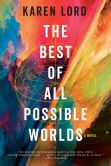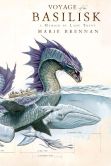Book Reviews: Lord & Brennan

Two more book reviews, starting with The Best of All Possible Worlds [Amazon | B&N | IndieBound], by Karen Lord. I received a copy of this one, along with The Galaxy Game, at ConFusion earlier this year. I loved Lord’s debut novel, so I was very much looking forward to what she did next.
Here’s the publisher’s description:
A proud and reserved alien society finds its homeland destroyed in an unprovoked act of aggression, and the survivors have no choice but to reach out to the indigenous humanoids of their adopted world, to whom they are distantly related. They wish to preserve their cherished way of life but come to discover that in order to preserve their culture, they may have to change it forever.
Now a man and a woman from these two clashing societies must work together to save this vanishing race-and end up uncovering ancient mysteries with far-reaching ramifications. As their mission hangs in the balance, this unlikely team - one cool and cerebral, the other fiery and impulsive - just may find in each other their own destinies . . . and a force that transcends all.
This is not whiz-bang, robots-and-lasers-and-spaceships-and-explosions science fiction. It’s a very thoughtful and well-written story of cultural displacement, interplanetary refugees, and the struggle between compromise and preservation of culture.
The Sadiri are described as “the epitome of morality and tradition, savants too absorbed in their mental exercises to succumb to base urges.” They arrive on the colony of Cygnus Beta after their homeworld is attacked and destroyed. Here, they set out to find settlements of genetically and culturally compatible humans, hoping to preserve as much of their ways as possible.
The narrator is Grace Delarua, part of the diplomatic party helping the Sadiri on their search. This sets up a somewhat episodic framework where we see different settlements and cultures, while at the same time learning more about the larger world and events, as well as getting a gradual romantic storyline between Grace and one of the Sadiri.
It’s a powerful book, exploring so many “what if” ideas - mental powers, time travel, planetary settlement - while at the same time being intensely relevant to our own world. It’s not a quick read, but it’s well worth reading.
#

I also recently read the second and third of Marie Brennan‘s Lady Trent books: The Tropic of Serpents [Amazon | B&N | IndieBound] and Voyage of the Basilisk [Amazon | B&N | IndieBound]. In some respects, these are similar to Lord’s book. They aren’t action-heavy sword-fighting quests, but thoughtful explorations of culture and science, presented as memoirs by Isabella (Lady Trent), who became the world’s foremost expert on dragons.
From the publisher:
The Tropic of Serpents: Three years after her fateful journeys through the forbidding mountains of Vystrana, Mrs. Camherst defies family and convention to embark on an expedition to the war-torn continent of Eriga, home of such exotic draconian species as the grass-dwelling snakes of the savannah, arboreal tree snakes, and, most elusive of all, the legendary swamp-wyrms of the tropics.
Voyage of the Basilisk: Six years after her perilous exploits in Eriga, Isabella embarks on her most ambitious expedition yet: a two-year trip around the world to study all manner of dragons in every place they might be found. From feathered serpents sunning themselves in the ruins of a fallen civilization to the mighty sea serpents of the tropics, these creatures are a source of both endless fascination and frequent peril. Accompanying her is not only her young son, Jake, but a chivalrous foreign archaeologist whose interests converge with Isabella’s in ways both professional and personal.
One of the things I love about this series is the protagonist’s passion for science and knowledge. We talk about sense of wonder, and Isabella conveys that wonder, not about big flashy magic or fancy special effects (not that there’s anything wrong with that!), but about discovery. She repeatedly risks her life, her reputation, and more for the chance to learn. She’s wonderfully and at times foolishly driven.
Like Lord, Brennan has developed a rich world. Brennan’s is based more closely on our own, drawing on cultures and countries from Europe, Africa, the Pacific Islands, and more. (Brennan’s background in anthropology helps a great deal, as does her intense research habits.) Over the course of the three books, we’ve seen much of that world and its people, but we also see a larger story about the progression of science and knowledge, and ongoing political conflicts.
One such story arc involves the preservation of dragon bones. Like birds, dragons have very light bones, but those bones are incredibly strong - so long as the dragon survives. Upon the animal’s death, the bones become fragile and crumble away into dust. Back in book one, Isabella and her companions discovered a way to preserve those bones, a process with many potential implications and uses … and one that has serious impacts on the hunting of dragons, not to mention the political fallout. Watching that knowledge spread, seeing the technological changes and Isabella’s struggle, is one of several wonderful storylines.
And of course, the books have great covers as well as internal illustrations, ostensibly by Lady Trent herself (with help from artist Todd Lockwood).
I look forward to the next!
Mirrored from Jim C. Hines.